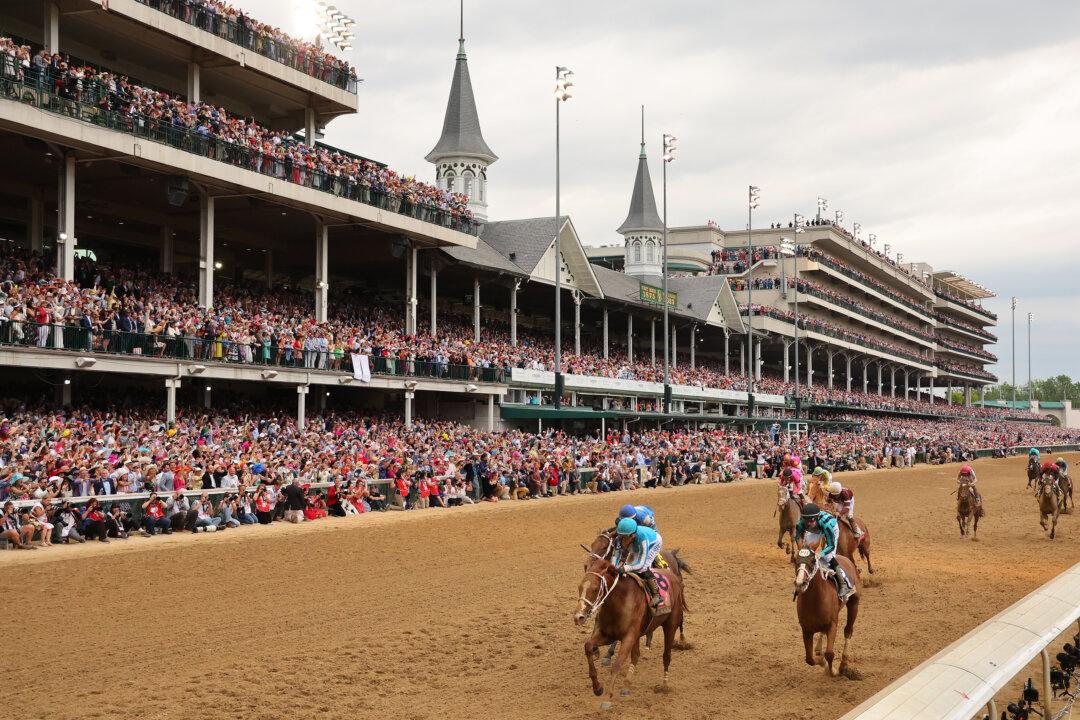In 1872, Meriwether Lewis Clark Jr. found himself very far from his Kentucky hometown of Louisville. The grandson of the famous explorer, William Clark (though named after Clark’s exploring companion Meriwether Lewis) had decided to visit Europe. His venture was not a leisure trip, but rather a business excursion to learn about the famous European horse-racing tracks.
Clark had grown up around horses and the lucrative sport of horse racing. This childhood familiarity with horses was due to the tragic death of his mother, only 13 days before his sixth birthday. He was thus sent to live with his two bachelor uncles, John and Henry Churchill. The Churchills lived on a large estate and introduced Clark to a rather lavish lifestyle, which often centered around the Woodlawn Course racetrack. This horse racing track had opened in 1859, and though initially successful, it was shuttered in 1870.

Louisville had become one of Kentucky’s prominent cities for horse racing. When the Woodlawn Course closed, breeders approached Clark about building a new one. Committed to building a racetrack facility worthy of the sport’s growing popularity, Clark made his way to Europe. There, he witnessed the Epsom Derby in England and the Grand Prix de Paris in France, as well as spending time with leaders of the English and French jockey clubs, Adm. Henry Rous and Vicomte Daru.
A Man and His Horse

Henry Price McGrath was a Kentuckian who always found a way to make money, though at times through shady dealings. From barrooms to gambling dens, McGrath had a gift for grift. He made his way to California for the Gold Rush and lured prospectors with gambling rooms. Having accumulated enough money, he moved to New Orleans where he opened up fancy gambling rooms. After the Civil War, he ran into problems with local authorities, who threw him into prison for a year. After serving his time, he moved to St. Louis and then to Saratoga Springs, New York, where he joined forces with John Morrissey, the bare-knuckle boxing champion turned horsetrack owner. McGrath operated gambling operations and also worked at the new Saratoga Race Course, which Morrissey had helped orchestrate.
After accumulating a vast profit from his gambling operations, McGrath moved to Lexington, Kentucky. One of his first decisions was to purchase 416 acres and build an opulent home modeled after one of the finest hotels in Saratoga Springs, the United States Hotel. On the acreage, which he called McGrathiana, he began purchasing and breeding thoroughbreds. His interest in horses and horse racing continued the rest of his life.
The Right Man for the Job
McGrath, however, needed a top-shelf trainer. He found one in Ansel Williamson. Williamson was born a slave in Virginia around 1810 and became one of the country’s leading horse trainers. The earliest available records as a trainer indicate he belonged to T.G. Goldsby, of Alabama, and trained Goldsby’s champion racer, Brown Dick. Williamson’s reputation became renown in the 1850s and through the Civil War. He was sold to A. Keene Richards, owner of Blue Grass Park in Kentucky, where he trained the leading horses Australian and Glycerna.In 1864, as the Civil War was ending, Williamson was purchased by Robert A. Alexander, the owner of the prestigious Woodburn Farm near Lexington and an admirer of Williamson (Alexander named one of his horses Ansel Williamson in 1856).
Upon obtaining his freedom with the end of the Civil War, Williamson remained in the employ of Alexander. Under Williams’s guidance, Alexander’s horse Asteroid was undefeated in 12 races.

Aristides and the Derby
During Tom Bowling’s successful run, Clark Jr. had begun formulating the idea for a prominent horse racing venue for Kentucky. As construction was underway for the new venue on the Churchill estate, Clark recommended the track be used for three races: a two-mile race that would be called the Clark Stakes, a 1.5-mile race called the Kentucky Oaks, and another 1.5-mile race to be called the Kentucky Derby.
By 1874, three of McGrath’s horses—Aristides, Calvin, and Chesapeake—were track-ready, but they raced in other Kentucky venues until Clark’s track was completed. It was on May 12, 1874, that Aristides made his racing debut, placing second in a half-mile sweepstakes in Lexington. The horse secured its first victory in a 1-mile race in Saratoga on Aug. 18.
By 1875, Clark’s racing venue, the Louisville Jockey Club racetrack, was completed and ready to host its first event. This inaugural event began the most famous horse-racing competition in America: the Kentucky Derby.
For the Derby, McGrath entered Aristides and Chesapeake. The plan was for Aristides to play the “rabbit” and open up the field for Chesapeake to win. Aristides would get out ahead of the pack of horses early during the 1.5-mile race, enabling Chesapeake to move ahead for the victory.
The First Kentucky Derby
It was during this week in history, 150 years ago, on May 17, 1875, that the first Kentucky Derby—later heralded as “The Most Exciting Two Minutes in Sports”—was held. Clark’s new venue welcomed 10,000 spectators, a sign that his new racing venue had a promising future.Luckily for McGrath, Lewis, Williamson, and Aristides, the track was dry. Fifteen riders, 13 (possibly 14) of whom were black, pulled up to a drawn line in the dirt. A flag was held in the air and then dramatically lowered. The horses were off. Aristides got to an early lead. Chesapeake, however, had got a late start, putting him well behind the frontrunners and putting McGrath’s plan in jeopardy.
Lewis urged Aristides ahead with all speed. The speedy blood-red chestnut horse proved his capacity for long races. Despite having exerted himself early, Aristides beat the field, winning the first Kentucky Derby by two lengths at a record pace of 2:37.75 for a three-year-old.
The air trembled again before Aristides and Lewis the following month at the Belmont Stakes. Aristides had pulled ahead in that race, but Calvin, McGrath’s other leading horse, was close by. McGrath had put a hefty bet on Calvin to win, and Lewis pulled up on Aristides enough to enable Calvin to take first. Aristides placed second, and McGrath walked away with $30,000 (around $872,000 today).

Life After the First Kentucky Derby
Lewis retired from jockeying to pursue a career as a bookmaker (then a legal enterprise). His bookmaking concepts are practically the modern format of today’s Daily Racing Form.Williamson continued a successful career as a trainer, retaining his place as one of the most respected and trusted in his industry. In 1998, he was inducted in the Racing Hall of Fame.
In 1915, McGrathiana was sold and renamed Coldstream Farm. It was operated by several Bluegrass farms until 1957, when it was sold to the University of Kentucky. It is now called Coldstream Research Campus.
The Louisville Jockey Club venue was renamed Churchill Downs in 1883 (or at least that is the first time the name was officially used). Churchill Downs financially struggled toward the end of the 19th century, but upon coming under the management of Col. Matt Winn in 1902, its financial situation quickly turned around and became one of the more successful sporting venues in the country.
Having started with 10,000 spectators for its first Kentucky Derby, the annual event now hosts approximately 165,000 (not including millions of television viewers). Additionally, in 1896, the length of the Kentucky Derby was changed from 1.5 miles to 1.25 miles. This was the same year the winner of the Kentucky Derby was given a large arrangement of roses, ultimately leading to the race often being referenced as the “Run for the Roses” (a term coined in 1925).
Aristides lived another 18 years after his Kentucky Derby victory, achieving a record of 9-5-1 and garnering more than $18,000 in winnings (more than $500,000 today). In 1987, a bronze statue of the blood-red chestnut horse with a white star on his forehead and a pair white socks on its back legs was placed in the Churchill Downs Paddock Tulip Garden. The Aristides Stakes at Churchill Downs was inaugurated the following year.









